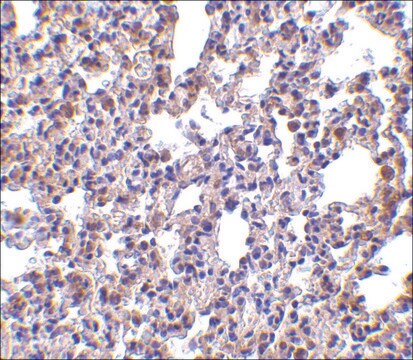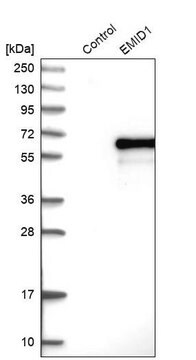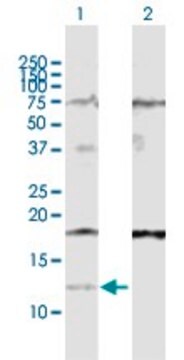推荐产品
生物源
rabbit
品質等級
共軛
unconjugated
抗體表格
affinity isolated antibody
抗體產品種類
primary antibodies
無性繁殖
polyclonal
形狀
buffered aqueous solution
分子量
predicted mol wt 29 kDa
物種活性
rat, mouse, human
濃度
1 mg/mL
技術
ELISA: suitable
immunoblotting: suitable
NCBI登錄號
UniProt登錄號
運輸包裝
wet ice
儲存溫度
−20°C
目標翻譯後修改
unmodified
基因資訊
human ... TMIGD1(388364)
一般說明
TMIGD1 (Transmembrane and immunoglobulin domain containing 1) is a novel adhesion molecule expressed in several organs and tissues, specifically in renal tubular epithelial cells. It is composed of two putative immunoglobulin domains, which mediates self-dimerization.
免疫原
Antibody was raised against an 18 amino acid peptide near the center of human TMIGD1.
應用
Anti-TMIGD1 antibody produced in rabbit is suitable for immunoblot and ELISA.
生化/生理作用
TMIGD1 (Transmembrane and immunoglobulin domain containing 1) is involved in various cellular processes such as regulation of cell structure, cell-cell adhesion, and cellular movement. Its extracellular domain stabilizes the cell morphology and cell-cell interaction. TMIGD1 plays an important role in cell survival by protecting it from oxidative cell injury. It protects cells from oxidative and nutrient-deprivation-induced cell injury by stabilizing the transepithelial electric resistance and permeability of renal epithelial cells.
特點和優勢
Evaluate our antibodies with complete peace of mind. If the antibody does not perform in your application, we will issue a full credit or replacement antibody. Learn more.
聯結
The action of this antibody can be blocked using blocking peptide SBP3501078.
外觀
Supplied at 1 mg/mL in PBS with 0.02% sodim azide.
免責聲明
Unless otherwise stated in our catalog or other company documentation accompanying the product(s), our products are intended for research use only and are not to be used for any other purpose, which includes but is not limited to, unauthorized commercial uses, in vitro diagnostic uses, ex vivo or in vivo therapeutic uses or any type of consumption or application to humans or animals.
未找到合适的产品?
试试我们的产品选型工具.
相關產品
儲存類別代碼
10 - Combustible liquids
閃點(°F)
Not applicable
閃點(°C)
Not applicable
Koji Fujimoto et al.
Gastroenterology, 123(6), 1941-1948 (2002-11-28)
The surface epithelium of the colon is being replaced constantly with cells derived from the stem cells of the crypt. Although the location of the stem cells is known, there are no markers for these cells. This study tested the
Junli Yan et al.
Proceedings of the National Academy of Sciences of the United States of America, 104(6), 1841-1846 (2007-02-01)
Tight regulation of p53 is essential for maintaining normal cell growth. Here we report that BLIMP1 acts in an autoregulatory feedback loop that controls p53 activity through repression of p53 transcription. p53 binds to and positively regulates BLIMP1, which encodes
Elisa Cattaneo et al.
EMBO molecular medicine, 3(6), 334-347 (2011-05-04)
Improved colonoscopy is revealing precancerous lesions that were frequently missed in the past, and ∼30% of those detected today have nonpolypoid morphologies ranging from slightly raised to depressed. To characterize these lesions molecularly, we assessed transcription of 23,768 genes in
Emad Arafa et al.
The American journal of pathology, 185(10), 2757-2767 (2015-09-08)
Oxidative damage to renal tubular epithelial cells is a fundamental pathogenic mechanism implicated in both acute kidney injury and chronic kidney diseases. Because epithelial cell survival influences the outcome of acute kidney injury and chronic kidney diseases, identifying its molecular
Hilary F Clark et al.
Genome research, 13(10), 2265-2270 (2003-09-17)
A large-scale effort, termed the Secreted Protein Discovery Initiative (SPDI), was undertaken to identify novel secreted and transmembrane proteins. In the first of several approaches, a biological signal sequence trap in yeast cells was utilized to identify cDNA clones encoding
我们的科学家团队拥有各种研究领域经验,包括生命科学、材料科学、化学合成、色谱、分析及许多其他领域.
联系技术服务部门![Pentanoic acid, 5-[[2-(2,6-dioxo-3-piperidinyl)-2,3-dihydro-1,3-dioxo-1H-isoindol-4-yl]amino]- ≥95%](/deepweb/assets/sigmaaldrich/product/structures/104/897/602a4feb-4867-4443-9433-4aa300643b4f/640/602a4feb-4867-4443-9433-4aa300643b4f.png)








